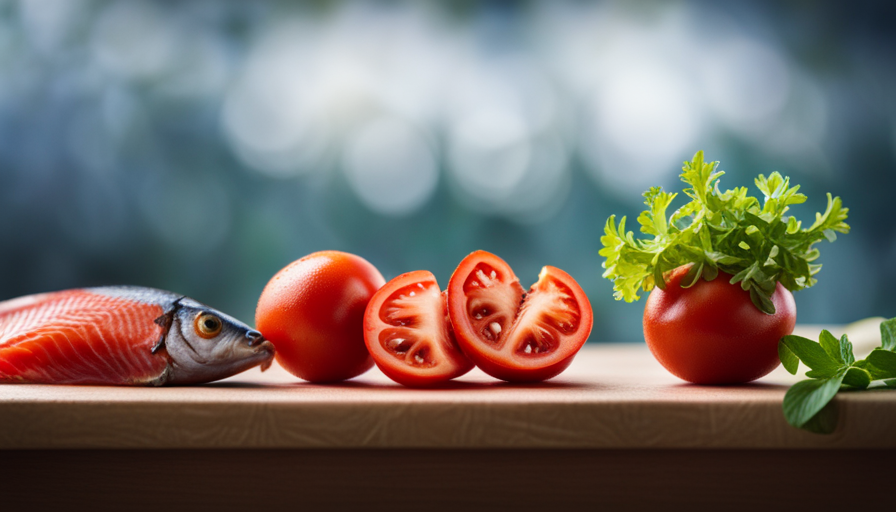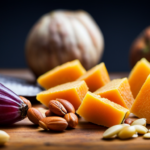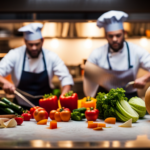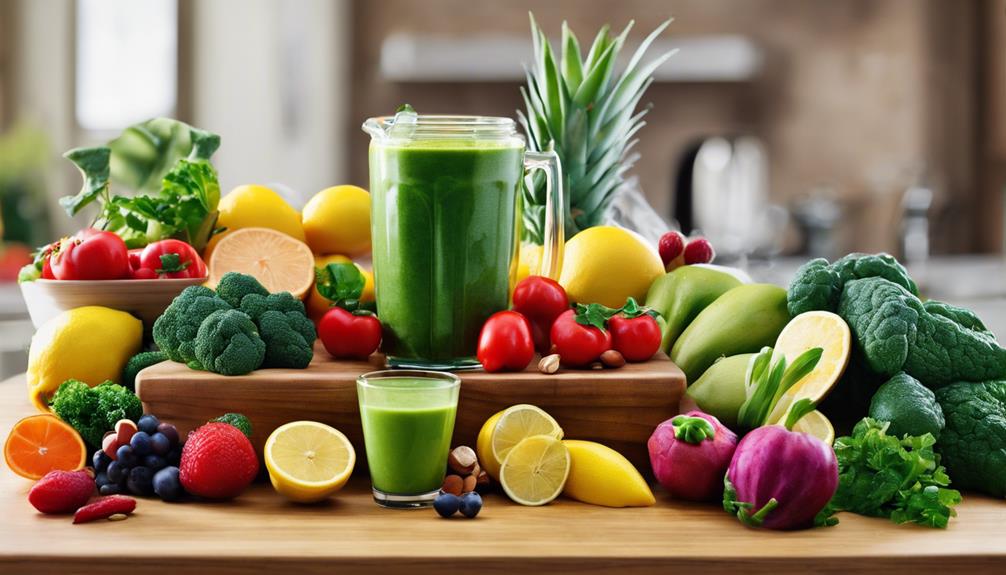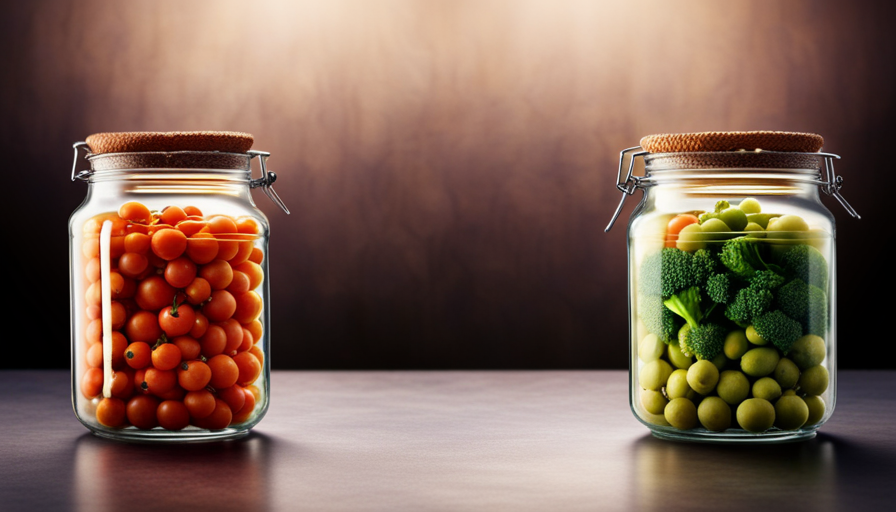Raw food. It may seem like just a passing food fad, but there’s a whole lot more to it. Get ready to discover the true secrets behind it. Come along for the journey!
In this article, I will delve deep into the world of raw food and uncover its true essence. Raw food, simply put, refers to food that has not been cooked or exposed to temperatures above 118°F (48°C). It is a lifestyle that promotes the consumption of natural, unprocessed, and uncooked foods. But don’t let its simplicity fool you; raw food has a myriad of health benefits. From increased energy levels to improved digestion, the advantages are plentiful.
However, navigating the world of raw food can be tricky, as different culinary traditions interpret it in various ways. Safety considerations, popular ingredients and recipes, and common misconceptions will also be explored.
So, join me on this journey as we unravel the mysteries of raw food and embrace a healthier, more sustainable lifestyle.
Key Takeaways
- Raw food refers to food that is not cooked or exposed to temperatures above 118°F (48°C).
- Raw food promotes the consumption of natural, unprocessed, and uncooked foods.
- Raw food is packed with essential nutrients like vitamins, minerals, and enzymes.
- Safety considerations, such as proper washing and handling of raw food, are important to minimize contamination risk.
Definition of Raw Food
So, you’re probably wondering what exactly ‘raw’ means when it comes to food, right? Well, let me break it down for you.
Raw food refers to any food that hasn’t been cooked or processed above a certain temperature, usually around 118°F (48°C). This means that raw food is consumed in its natural state, without any alterations that might occur during the cooking process.
There are several health benefits associated with eating raw food. Firstly, raw food is packed with essential nutrients, such as vitamins, minerals, and enzymes, which can be destroyed by heat. By consuming raw food, you’re ensuring that you get the maximum amount of these nutrients, which can contribute to overall health and well-being.
Additionally, raw food is often lower in calories and higher in fiber than cooked food, making it a great option for weight management.
However, it’s important to consider safety considerations when consuming raw food. Raw food may contain harmful bacteria and parasites that can cause foodborne illnesses. Therefore, it’s crucial to properly wash and handle raw food to minimize the risk of contamination. Additionally, individuals with weakened immune systems, such as pregnant women, young children, and the elderly, should exercise caution when consuming raw food.
Understanding the definition of raw food is essential to fully grasp its health benefits and safety considerations. Now, let’s explore the health benefits of eating raw food.
Health Benefits of Eating Raw Food
Interestingly, indulging in uncooked cuisine can surprisingly provide a plethora of health advantages. Here are four health benefits of eating raw food:
-
Increased Nutrient Intake: Raw food retains more nutrients compared to cooked food, as high temperatures can degrade certain vitamins and enzymes. By consuming raw fruits, vegetables, and nuts, you can ensure a higher intake of essential vitamins, minerals, and antioxidants.
-
Improved Digestion: Raw food is rich in dietary fiber, which aids in digestion and promotes regular bowel movements. Additionally, the natural enzymes present in raw food help break down complex nutrients, making them easier to absorb by the body.
-
Weight Management: Raw food is generally low in calories and high in water content, which can help in weight management. The fiber in raw food also provides a feeling of fullness, reducing the chances of overeating.
-
Enhanced Energy Levels: Raw food is often considered more ‘alive’ due to its high enzyme content. These enzymes can support the body’s metabolic processes, leading to increased energy levels and improved overall vitality.
Transitioning to a raw food diet may require some adjustments. To ease the transition, gradually incorporate raw foods into your meals, experiment with different recipes, and ensure a balanced intake of nutrients.
Moving forward, let’s explore the different interpretations of raw food across culinary traditions.
Different Interpretations of Raw Food Across Culinary Traditions
Across various culinary traditions, there exist diverse interpretations of incorporating uncooked ingredients into dishes. Different cultural perspectives and historical roots have shaped the way raw food is understood and prepared around the world.
In some cultures, such as Japan, raw fish is a staple in dishes like sushi and sashimi. The focus is on using the freshest ingredients and minimal seasoning to let the natural flavors shine.
In contrast, Mediterranean cuisine embraces raw vegetables and fruits in dishes like tabbouleh and gazpacho, where the ingredients are chopped or blended together to create a refreshing and nutrient-rich meal.
These interpretations of raw food highlight the importance of cultural and historical influences on culinary practices. They demonstrate how different societies have found ways to incorporate uncooked ingredients into their diets, taking advantage of the benefits that raw food can offer. From preserving nutrients to enhancing flavors, each culture has developed its own unique approach to raw food.
Transitioning into the subsequent section about safety considerations for eating raw food, it’s important to understand that while there are many health benefits associated with consuming raw food, there are also potential risks involved.
Safety Considerations for Eating Raw Food
To fully embrace the benefits of incorporating uncooked ingredients into your diet, it’s crucial to be aware of the potential safety considerations involved. While raw food can provide a range of health benefits, there are also some health risks to consider. Here are some important safety tips to keep in mind when transitioning to a raw food diet:
-
Wash fruits and vegetables thoroughly: Raw fruits and vegetables may harbor bacteria or pesticides, so it’s important to wash them well before consuming.
-
Handle raw meat with caution: If you choose to include raw meat in your diet, make sure to handle it separately from other ingredients and ensure it’s fresh and of good quality.
-
Avoid cross-contamination: Keep raw and cooked foods separate to prevent the transfer of harmful bacteria.
-
Be mindful of foodborne illnesses: Raw food can increase the risk of foodborne illnesses such as salmonella or E. coli. It’s important to store and handle all ingredients properly to minimize this risk.
-
Gradually transition to a raw food diet: It’s advisable to gradually incorporate raw foods into your diet to allow your body to adjust and avoid potential digestive issues.
By following these safety considerations, you can minimize the health risks associated with raw food and enjoy its benefits.
In the next section, we’ll explore popular raw food ingredients and recipes, providing inspiration for incorporating more raw food into your meals.
Popular Raw Food Ingredients and Recipes
Raw fruits and vegetables are a key component of a raw food diet, as they provide essential vitamins, minerals, and antioxidants. Incorporating raw nuts and seeds into your diet can provide a good source of healthy fats, protein, and fiber.
Raw dairy and fermented foods are also popular choices for those following a raw food diet, as they can provide probiotics and enzymes that support digestion and overall gut health.
Raw Fruits and Vegetables
Eating raw fruits and vegetables can be a refreshing and vibrant way to nourish your body. Raw food benefits include higher nutrient content, as cooking can sometimes lead to nutrient loss. Additionally, raw fruits and vegetables are rich in fiber, which aids in digestion and promotes a healthy gut.
To showcase the vibrancy of raw fruits and vegetables, here is a table highlighting their various colors and corresponding health benefits:
| Color | Health Benefits |
|---|---|
| Red | Rich in antioxidants |
| Orange | High in vitamin C |
| Yellow | Boosts immune system |
| Green | Excellent source of chlorophyll |
| Purple | Supports brain health |
| White | Enhances heart health |
Incorporating raw fruits and vegetables into your diet is an easy and delicious way to reap their many benefits. Now, let’s transition to the next section about raw nuts and seeds.
Raw Nuts and Seeds
After exploring the benefits of consuming raw fruits and vegetables, it’s time to delve into the world of raw nuts and seeds.
Raw nuts and seeds are nutrient powerhouses that provide essential fats, protein, and various vitamins and minerals. One popular way to consume raw nuts is by making raw nut butter. This involves grinding the nuts into a smooth, spreadable consistency. This process retains the natural oils and nutrients present in the nuts, making it a healthy and flavorful alternative to conventional nut butters.
Additionally, soaking nuts before consuming them helps to remove enzyme inhibitors and increase their digestibility. Soaking also activates enzymes and breaks down phytic acid, improving nutrient absorption.
By incorporating raw nut butter and soaking nuts into our diet, we can unlock their full nutritional potential.
Moving forward, let’s explore the next section on raw dairy and fermented foods.
Raw Dairy and Fermented Foods
Indulging in creamy, tangy yogurt and rich, velvety cheeses made from raw dairy creates a sensory experience that transports you to a quaint farmhouse surrounded by rolling green pastures. Fermented dairy products, such as yogurt and kefir, are staples in raw food diets due to their numerous health benefits. These probiotic-rich foods are known to improve digestion, boost immune function, and promote overall gut health. Raw dairy products are made from unpasteurized milk, which preserves the natural enzymes and beneficial bacteria present in the milk. These enzymes aid in digestion and nutrient absorption, while the bacteria support a healthy balance of gut flora. Incorporating raw dairy and fermented foods into your diet can be a delicious and nutritious way to enhance your overall well-being.
Transition: Now that we’ve explored the world of raw dairy and fermented foods, let’s move on to some tips for incorporating raw food into your diet.
Tips for Incorporating Raw Food into Your Diet
When incorporating raw food into my diet, I found that a gradual transition was key. I started by adding more raw fruits and vegetables to my meals, and slowly reducing the amount of cooked foods I consumed.
Experimenting with different raw food preparation techniques also helped me discover new flavors and textures.
Lastly, seeking guidance from raw food experts provided me with valuable advice and resources to ensure I was getting all the necessary nutrients.
Gradual Transitioning
As you begin to incorporate more raw foods into your diet, you’ll gradually transition to a healthier and more nutrient-dense way of eating. Transitioning to a raw food diet can be challenging, but there are various techniques that can help ease the process. One effective technique is to start by replacing one cooked meal with a raw meal each day, gradually increasing the number of raw meals over time. This allows your body to adjust to the change and helps in avoiding any digestive discomfort. Additionally, it is important to consider the nutritional aspects of your diet during this transition. Ensuring a variety of fruits, vegetables, nuts, seeds, and legumes will provide the essential vitamins, minerals, and antioxidants needed for optimal health. Experimenting with new raw food preparation techniques can also make your transition more exciting and enjoyable. By exploring different ways to prepare raw meals, you can discover delicious and innovative ways to incorporate more raw foods into your diet.
Experimenting with Raw Food Preparation Techniques
Try incorporating some creative and inventive ways to prepare your meals with raw ingredients, and watch as your taste buds explode with delight.
Experimenting with raw food techniques allows you to explore the vast potential of raw ingredients and discover new flavors and textures.
One technique you can try is marinating vegetables in a mixture of olive oil, lemon juice, and herbs to enhance their taste and tenderize them.
Another technique is using a spiralizer to turn zucchini into noodles, creating a refreshing and healthy alternative to traditional pasta.
Additionally, you can experiment with dehydrating fruits and vegetables to create crunchy and nutritious snacks.
By exploring different raw food preparation techniques, you can truly elevate your culinary experience.
Seeking guidance from raw food experts will further enhance your knowledge and provide valuable insights into this exciting culinary journey.
Seeking Guidance from Raw Food Experts
To truly enhance your culinary skills and dive deep into the world of raw food, why not seek guidance from the experts who can provide valuable insights and take your cooking to the next level?
Raw food preparation techniques can be complex and require specific knowledge to ensure food safety and maximize nutritional value. Transitioning to raw food can be a challenging process, but with the guidance of raw food experts, you can learn the best practices for preparing delicious and nutritious raw meals.
These experts can teach you about proper food handling, equipment usage, and ingredient selection to create vibrant and flavorful dishes. By learning from the raw food experts, you can gain a deeper understanding of the principles behind raw food preparation and unlock your creative potential in the kitchen.
Now, let’s explore some common misconceptions about raw food.
Common Misconceptions about Raw Food
Did you know that despite common misconceptions, raw food actually retains more vitamins and nutrients than cooked food? Many people believe that cooking food is necessary to make it safe to eat and to enhance its nutritional value. However, this is not always the case. In fact, cooking can actually destroy some of the beneficial compounds found in raw food.
One common misconception about raw food is that it is less safe to eat than cooked food. While it is true that certain raw foods, such as meat and eggs, can pose a higher risk of foodborne illnesses, this risk can be minimized by sourcing high-quality, fresh ingredients and practicing proper food handling and storage techniques.
Another misconception is that raw food lacks flavor and variety. This couldn’t be further from the truth. Raw food can be incredibly flavorful and diverse, offering a wide range of textures and tastes. From fresh fruits and vegetables to raw nuts, seeds, and sprouts, there are countless delicious options to explore.
To further emphasize the benefits of raw food, consider the following table:
| Benefits of Raw Food |
|---|
| Retains more vitamins and nutrients |
| Boosts digestion and absorption |
| Supports a healthy immune system |
| Promotes natural detoxification |
| Enhances energy and vitality |
As we transition to the next section about raw food and sustainability, it is important to recognize that raw food can not only be nutritious and delicious but also have a positive impact on the environment.
Raw Food and Sustainability
When discussing the topic of raw food and sustainability, it’s important to consider the reduced energy consumption associated with this dietary choice. Raw food diets often require less energy for cooking and processing, leading to a more environmentally friendly approach to food preparation.
Additionally, following a raw food diet can also result in minimal food waste, as the focus is on consuming whole, unprocessed foods that are less likely to spoil or be thrown away.
Lastly, embracing raw food can support local and organic farming practices. Many raw food enthusiasts prioritize sourcing their ingredients from local farmers and choosing organic options whenever possible, further contributing to a more sustainable food system.
Reduced Energy Consumption
Switching to a raw food diet can significantly lower your energy consumption. By choosing raw foods, you’re opting for reduced environmental impact and making sustainable food choices.
Raw foods require less energy to produce and process compared to cooked or processed foods. This is because cooking and processing involve the use of appliances, such as stoves and ovens, which consume electricity or gas. Raw foods, on the other hand, can be eaten directly without the need for cooking or processing, leading to a reduction in energy usage.
Additionally, raw foods often come from local sources, further reducing the energy required for transportation. By embracing a raw food diet, you can contribute to a more sustainable future by minimizing your energy consumption and its associated environmental impact. Furthermore, this shift towards raw foods can also lead to minimal food waste.
Minimal Food Waste
Reducing energy consumption is just one aspect of making sustainable choices when it comes to food. Another important factor is minimizing food waste. This means finding ways to reduce the amount of food that is thrown away, whether it’s by individuals, restaurants, or grocery stores.
There are several strategies that can be employed to achieve this goal. One is better inventory management, ensuring that food is used before it spoils. Another is implementing composting programs to turn food scraps into nutrient-rich soil. Additionally, innovative packaging solutions can help extend the shelf life of perishable items.
By reducing waste, we not only conserve resources but also decrease the environmental impact associated with food production and disposal.
This sets the stage for the next topic, which explores the support for local and organic farming.
Support for Local and Organic Farming
Seek out sustainable solutions by supporting local and organic farming for a more environmentally-friendly and ethically-conscious approach to your food choices. By purchasing produce and products from local farmers who follow organic practices, you’re contributing to the creation of supportive communities and reducing the environmental impact of food production.
Local and organic farming methods prioritize the use of natural fertilizers and pest control, minimizing the reliance on harmful chemicals. Additionally, supporting local farmers helps to reduce the carbon footprint associated with transporting food long distances. By choosing local and organic options, you’re not only making a positive impact on the environment but also supporting the livelihoods of small-scale farmers in your community.
Transitioning to the next section, let’s explore the benefits of incorporating raw food products and tools into your diet.
Raw Food Products and Tools
When it comes to raw food snacks and desserts, there are a wide variety of delicious options available. These snacks and desserts are made from purely raw and unprocessed ingredients, ensuring that they retain all of their natural nutrients and flavors.
In order to prepare these raw food snacks and desserts, it’s important to have the necessary tools, such as spiralizers and dehydrators, which help to create unique textures and flavors.
Raw Food Snacks and Desserts
Raw food snacks and desserts are a delicious and nutritious way to satisfy your sweet tooth while still maintaining a healthy lifestyle. Incorporating raw food into your diet has numerous benefits, including increased nutrient intake, improved digestion, and enhanced energy levels.
Raw food recipes for snacks and desserts often include ingredients such as nuts, seeds, fruits, and vegetables, which are packed with essential vitamins, minerals, and antioxidants. These raw treats can be easily prepared at home, and there are countless recipes available online to suit various dietary preferences and taste preferences.
To make these delectable snacks and desserts, you may need raw food preparation equipment such as spiralizers and dehydrators, which help create unique textures and flavors. So, let’s now explore the world of raw food preparation equipment and discover how these tools can elevate your raw food creations.
Raw Food Preparation Equipment (e.g., Spiralizers, Dehydrators)
Moving on from discussing raw food snacks and desserts, let’s now explore the essential equipment used in preparing raw food. To achieve the desired texture and presentation, certain tools like spiralizers and dehydrators play a crucial role. A spiralizer is a handy device that transforms vegetables into beautiful spirals, ribbons, or noodles. It not only adds variety and creativity to raw food dishes but also enhances the visual appeal. On the other hand, dehydrators are used to remove moisture from foods while preserving their nutrients and flavors. They are particularly useful for creating delectable raw food recipes like dried fruits, vegetable chips, and even raw granola bars. By incorporating these innovative tools into our kitchen, we can effortlessly prepare nutritious and visually appealing raw food dishes. Now, let’s explore the conclusion: embracing the raw food lifestyle.
Conclusion: Embracing the Raw Food Lifestyle
In conclusion, embracing the raw food lifestyle allows individuals to experience a multitude of health benefits, a heightened sense of energy, and a stronger immune system. This way of eating emphasizes simplicity and maximizing nutrition, providing the body with all the necessary nutrients in their most natural form.
Here are four key reasons why embracing the raw food lifestyle can be beneficial:
-
Increased nutrient intake: Raw foods are rich in vitamins, minerals, and enzymes that can be lost during cooking. By consuming foods in their raw state, we ensure that we’re getting the maximum amount of nutrients possible.
-
Improved digestion: Raw foods are easier for the body to digest compared to cooked foods. This can lead to fewer digestive issues such as bloating, gas, and constipation.
-
Enhanced energy levels: Raw foods are packed with natural energy sources, such as fruits and vegetables. By fueling our bodies with these high-energy foods, we can experience a sustained boost in energy throughout the day.
-
Strengthened immune system: Raw foods are full of antioxidants and phytochemicals that help support a healthy immune system. These nutrients protect our bodies from harmful pathogens and can reduce the risk of chronic diseases.
By embracing the raw food lifestyle, individuals can optimize their health and well-being by nourishing their bodies with nutrient-dense, unprocessed foods.
Frequently Asked Questions
Can I eat raw meat or fish as part of a raw food diet?
Yes, raw meat and fish can be consumed as part of a raw food diet. However, it’s crucial to ensure raw meat safety by selecting high-quality, fresh cuts and properly storing and handling them. Raw meat provides essential nutrients, such as protein, vitamins, and minerals, which are often lost during cooking. Additionally, a raw food diet can offer benefits such as increased enzyme intake, improved digestion, and enhanced nutrient absorption.
Are there any risks or concerns associated with consuming raw food?
There are several risks and concerns associated with consuming raw food. One major concern is the potential for foodborne illnesses, such as salmonella or E. coli, which can be present in raw meats or seafood.
Another risk is the possibility of nutrient deficiencies, as cooking can enhance the bioavailability of certain nutrients.
Additionally, raw foods may contain natural toxins or contaminants that can be harmful to our health.
It’s important to carefully consider these risks before incorporating raw food into our diet.
How can I ensure that I am getting all the necessary nutrients from a raw food diet?
Ensuring nutrient intake on a raw food diet can be challenging. Raw food diets typically consist of uncooked fruits, vegetables, nuts, and seeds. While these foods are rich in vitamins, minerals, and antioxidants, there are some nutrients that may be lacking. It’s important to make sure you’re getting enough protein, iron, calcium, and vitamin B12, which are commonly found in animal products. Including a variety of plant-based protein sources and fortified foods or supplements can help meet these nutrient needs.
Are there any specific cooking methods that are considered acceptable within the raw food movement?
When it comes to the raw food movement, there are specific cooking techniques and food preparation methods that are considered acceptable. These methods focus on preserving the nutritional value of the food by avoiding high heat and prolonged cooking times.
Techniques such as soaking, sprouting, blending, and dehydrating are commonly used in the raw food community. These methods help to retain the natural enzymes, vitamins, and minerals present in the food, making it a popular choice for those seeking a nutrient-dense diet.
Can children and pregnant women safely follow a raw food diet?
Safety concerns and nutritional adequacy are important considerations when it comes to children and pregnant women following a raw food diet. While the raw food movement promotes the consumption of uncooked and minimally processed foods, it is crucial to note that these diets may pose potential risks, especially for vulnerable populations.
Raw diets may be lacking in certain nutrients and can increase the risk of foodborne illnesses. Therefore, it’s advisable to consult with a healthcare professional before embarking on a raw food diet during pregnancy or for children.
How is the concept of “raw” applied differently in the food industry compared to raw food for consumption?
In the food industry, raw materials are used to create processed and packaged foods. These raw materials in the food industry are typically ingredients such as grains, fruits, vegetables, and meats that are used to make a wide variety of products. In contrast, raw food for consumption refers to uncooked, unprocessed foods that are eaten in their natural state.
Conclusion
In conclusion, embracing the raw food lifestyle can offer numerous health benefits and contribute to sustainability efforts. By consuming raw food, individuals can maximize the intake of essential nutrients and enzymes while minimizing the loss of nutrients through cooking.
Additionally, incorporating raw food into our diets can help reduce carbon footprint and support local farmers who produce organic produce. For example, a case study conducted on a group of individuals who adopted a raw food diet showed significant improvements in their overall well-being, including increased energy levels and improved digestion.
Thus, by incorporating raw food into our daily meals, we can enhance our health and contribute to a more sustainable future.

